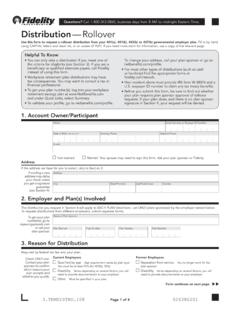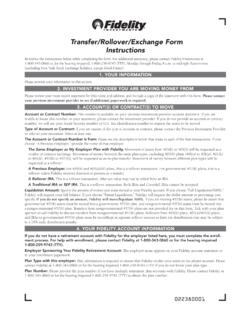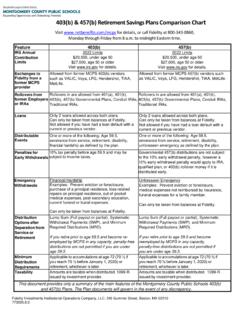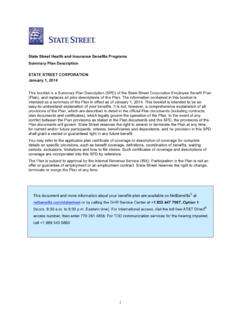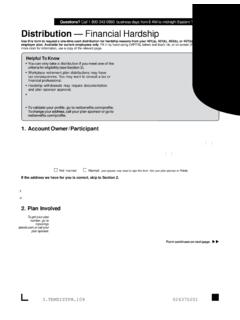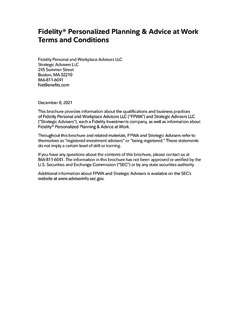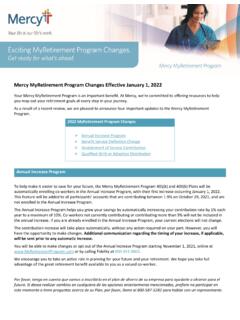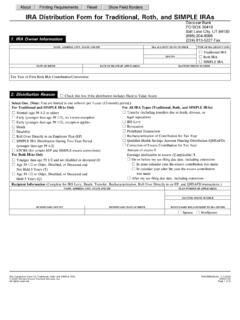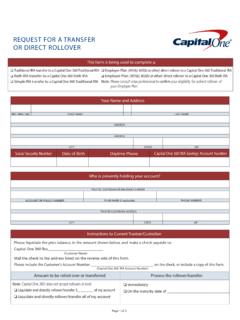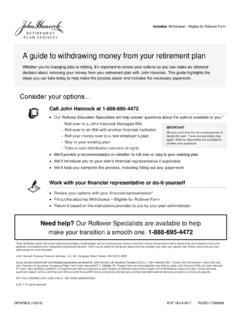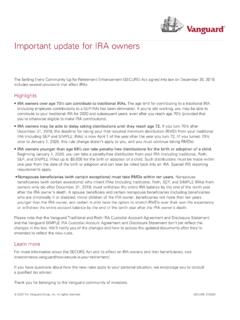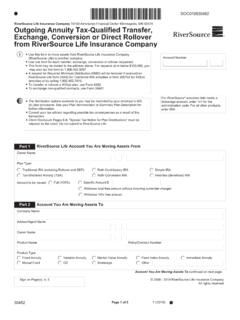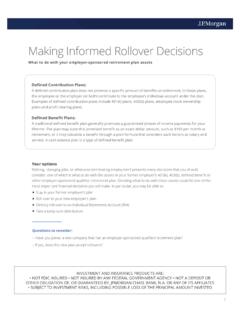Transcription of SPECIAL TAX NOTICE YOUR ROLLOVER OPTIONS GENERAL ...
1 1 SPECIAL TAX NOTICE YOUR ROLLOVER OPTIONS You are receiving this NOTICE because all or a portion of a payment you are receiving from the Plan is eligible to be rolled over to either an IRA or an employer plan; or if your payment is from a designated Roth account, to a Roth IRA or designated Roth account in an employer plan. This NOTICE is intended to help you decide whether to do such a ROLLOVER . This NOTICE describes the ROLLOVER rules that apply to payments from the Plan. To the extent that the rules differ based on whether the payment is from a Designated Roth Account or from an account that is Not a Designated Roth Account, those differences will be identified in each section of this NOTICE . Rules that apply to most payments from a plan are described in the GENERAL Information About rollovers section.
2 SPECIAL rules that only apply in certain circumstances are described in the SPECIAL Rules and OPTIONS section. GENERAL INFORMATION ABOUT rollovers How can a ROLLOVER affect my taxes? Not a Designated Roth Account: You will be taxed on a payment from the Plan if you do not roll it over. If you are under age 59 and do not do a ROLLOVER , you will also have to pay a 10% additional income tax on early distributions (unless an exception applies). However, if you do a ROLLOVER , you may not have to pay tax until you receive payments later and the 10% additional income tax will not apply if those payments are made after you are age 59 (or if an exception applies). If you do a ROLLOVER to a Roth IRA, any amounts not previously included in your income will be taxed currently (see the section below titled "If you roll over your payment to a Roth IRA (Not a Designated Roth Account)").
3 Designated Roth Account: After-tax contributions included in a payment from a designated Roth account are not taxed, but earnings might be taxed. The tax treatment of earnings included in the payment depends on whether the payment is a qualified distribution. If a payment is only part of your designated Roth account, the payment will include an allocable portion of the earnings in your designated Roth account. If the payment from the Plan is not a qualified distribution and you do not do a ROLLOVER to a Roth IRA or a designated Roth account in an employer plan, you will be taxed on the earnings in the payment. If you are under age 59 , a 10% additional income tax on early distributions will also apply to the earnings (unless an exception applies).
4 However, if you do a ROLLOVER , you will not have to pay taxes currently on the earnings and you will not have to pay taxes later on payments that are qualified distributions. If the payment from the Plan is a qualified distribution, you will not be taxed on any part of the payment even if you do not do a ROLLOVER . If you do a ROLLOVER , you will not be taxed on the amount you roll over and any earnings on the amount you roll over will not be taxed if paid later in a qualified distribution. A qualified distribution from a designated Roth account in the Plan is a payment made after you are age 59 (or after your death or disability) and after you have had a designated Roth account in the Plan for at least 5 years. In applying the 5-year rule, you count from January 1 of the year your first contribution was made to the designated Roth account.
5 However, if you did a direct ROLLOVER to a designated Roth account in the Plan from a designated Roth account in another employer plan, your participation will count from January 1 of the year your first contribution was made to the designated Roth account in the Plan or, if earlier, to the designated Roth account in the other employer plan. Where may I roll over the payment? Not a Designated Roth Account: You may roll over the payment to either an IRA (an individual retirement account or individual retirement annuity) or an employer plan (a tax-qualified plan, section 403(b) plan, or governmental section 457(b) plan) that will accept the ROLLOVER . The rules of the IRA or employer plan that holds the ROLLOVER will determine your investment OPTIONS , fees, and rights to payment from the IRA or employer plan (for example, no spousal consent rules apply to IRAs and IRAs may not provide loans).
6 Further, the amount rolled over will become subject to the tax rules that apply to the IRA or employer plan. If your plan provides for a Designated Roth Account, it may also allow in-plan Roth conversions of amounts not currently held in the Designated Roth Account. See the section below titled If your plan allows in-plan Roth conversions for more information. Designated Roth Account: You may roll over the payment to either a Roth IRA (a Roth individual retirement account or Roth individual retirement annuity) or a Designated Roth Account in an employer plan (a tax-qualified plan, section 403(b) plan, or governmental section 457(b) 2 plan) that will accept the ROLLOVER . The rules of the Roth IRA or employer plan that holds the ROLLOVER will determine your investment OPTIONS , fees, and rights to payment from the Roth IRA or employer plan (for example, no spousal consent rules apply to Roth IRAs and Roth IRAs may not provide loans).
7 Further, the amount rolled over will become subject to the tax rules that apply to the Roth IRA or the Designated Roth Account in the employer plan. In GENERAL , these tax rules are similar to those described elsewhere in this NOTICE , but differences include: If you do a ROLLOVER to a Roth IRA, all of your Roth IRAs will be considered for purposes of determining whether you have satisfied the 5-year rule (counting from January 1 of the year for which your first contribution was made to any of your Roth IRAs). If you do a ROLLOVER to a Roth IRA, you will not be required to take a distribution from the Roth IRA during your lifetime and you must keep track of the aggregate amount of the after-tax contributions in all of your Roth IRAs (in order to determine your taxable income for later Roth IRA payments that are not qualified distributions).
8 Eligible ROLLOVER distributions from a Roth IRA can only be rolled over to another Roth IRA. How do I do a ROLLOVER ? There are two ways to do a ROLLOVER . You can do either a direct ROLLOVER or a 60-day ROLLOVER . If you do a direct ROLLOVER , the Plan will make the payment directly to your IRA or an employer plan, or if your payment is from a Designated Roth Account, to your Roth IRA or Designated Roth Account in an employer plan. You should contact the IRA or Roth IRA custodian or the administrator of the employer plan for information on how to do a direct ROLLOVER . If you do not do a direct ROLLOVER , you may still do a ROLLOVER by making a deposit within 60 days according to the rules below: Not a Designated Roth Account: You may make a deposit into an IRA or eligible employer plan that will accept it.
9 You will have 60 days after you receive the payment to make the deposit. If you do not do a direct ROLLOVER , the Plan is required to withhold 20% of the payment for federal income taxes (up to the amount of cash and property received other than employer stock). This means that, in order to roll over the entire payment in a 60-day ROLLOVER , you must use other funds to make up for the 20% withheld. If you do not roll over the entire amount of the payment, the portion not rolled over will be taxed and will be subject to the 10% additional income tax on early distributions if you are under age 59 (unless an exception applies). If you do a ROLLOVER of only a portion of the payment made to you, any nontaxable amounts are treated as being rolled over last.
10 Designated Roth Account: You may make a deposit within 60 days into a Roth IRA, whether the payment is a qualified or nonqualified distribution. In addition, you can do a ROLLOVER by making a deposit within 60 days into a designated Roth account in an employer plan if the payment is a nonqualified distribution and the ROLLOVER does not exceed the amount of the earnings in the payment. You cannot do a 60-day ROLLOVER to an employer plan of any part of a qualified distribution. If you receive a distribution that is a nonqualified distribution and you do not roll over an amount at least equal to the earnings allocable to the distribution, you will be taxed on the amount of those earnings not rolled over, including the 10% additional income tax on early distributions if you are under age 59 (unless an exception applies).
